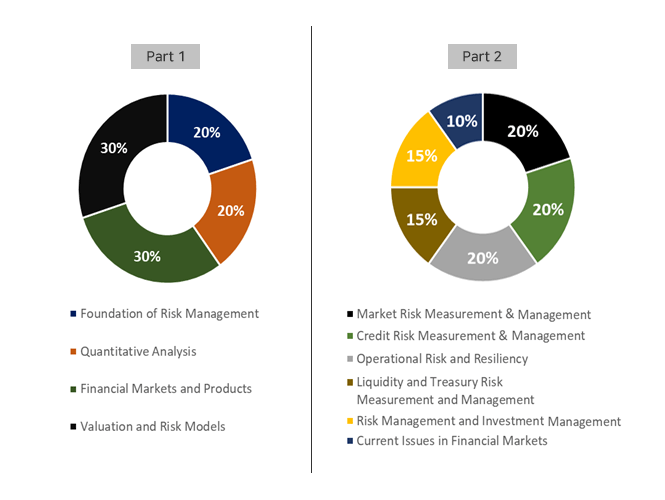
FRM 자격시험은 1997년부터 시행되어 CFA ∙ CPA에 등에 비해 비교적 신생 자격시험입니다. 따라서 전통이 깊은 CFA, CPA의 경우에 시험주제가 잘 확립된 데 반하여 FRM의 시험주제는 점진적으로 확대되고 있으며 시험의 난이도 또한 높아지고 있는 추세입니다.
FRM 시험의 특징 중의 하나는 이론적 지식뿐만 아니라 자본시장에 관련된 각종 법규 및 real-world environment를 고려한 문제가 출제된다는 점입니다. FRM의 주요 시험과목 및 출제 비중은 다음과 같습니다.

| Topic | Part 1 | Part 2 |
|---|---|---|
| Foundation of Risk Management | 20% | |
| Quantitative Analysis | 20% | |
| Financial Markets and Products | 30% | |
| Valuation and Risk Models | 30% | |
| Market Risk Measurement & Management | 20% | |
| Credit Risk Measurement & Management | 20% | |
| Operational Risk and Resiliency | 20% | |
| Liquidity and Treasury Risk Measurement and Management | 15% | |
| Risk Management and Investment Management | 15% | |
| Current Issues in Financial Markets | 10% | |
| Total | 100% | 100% |
Ⅰ. Foundations of Risk Management
리스크 관리의 기초적인 지식을 학습하는 과목으로 증권시장의 효율성과 증권가격의 결정원리, 포트폴리오 성과분석 및 리스크관리 실태원인과 금융윤리 등을 학습합니다.
- Basic risk types, measurement and management tools
- Creating value with risk management
- Risk governance and corporate governance
- Credit risk transfer mechanisms
- The Capital Asset Pricing Model (CAPM)
- Risk-adjusted performance measurement
- Multifactor models
- Data aggregation and risk reporting
- Financial disasters and risk management failures
- Ethics and the GARP Code of Conduct
II. Quantitative Analysis
통계학적인 기본 개념을 바탕으로 각종 재무위험을 추정하고 관리할 수리적 기법의 기초과목으로써 화폐의 시간가치, 확률분포이론, 상관관계분석 및 회귀분석이 주요 주제가 됩니다.
- Discrete and continuous probability distributions
- Estimating the parameters of distributions
- Population and sample statistics
- Bayesian analysis
- Statistical inference and hypothesis testing
- Measures of correlation
- Linear regression with single and multiple regressors
- Time series analysis and forecasting
- Simulation methods
III. Financial Markets and Products
금융시장의 작동구조와 사장파생상품의 속성 및 가격 결정원리, 헤지방법에 대해 학습합니다. 또한 채권과 신용위험을 관리하기 위한 기본적 기법들을 학습합니다.
- Structures and functions of financial institutions
- Structure and mechanics of over-the-counter (OTC) and exchange markets
- Structure, mechanics and valuation of forwards, futures, swaps and options
- Hedging with derivatives
- Interest rates and measures of interest rate sensitivity
- Foreign exchange risk
- Corporate bonds
- Mortgage-backed securities
IV. Valuation and Risk Models
보유자산의 가치에 변동을 일으키는 위험 요소의 발견 및 변동성 추정, 시장리스크와 신용리스크를 계량화하기 위한 기법들을 학습합니다.
- Value-at-Risk (VaR)
- Expected shortfall (ES)
- Estimating volatility and correlation
- Economic and regulatory capital
- Stress testing and scenario analysis
- Option valuation
- Fixed income valuation
- Hedging
- Country and sovereign risk models and management
- External and internal credit ratings
- Expected and unexpected losses
- Operational risk
Part II는 PartⅠ에서 배운 tool의 지식을 기반으로 더 깊이 있게 학습함과 동시에 실제 risk 관련 사항들에 대해 학습내용을 적용 ∙ 응용하는데 초점을 맞추고 있습니다.
V. Market Risk Measurement and Management
채권 및 각종파생상품(선물, 옵션, 스왑 등)의 구조 가격결정 및 거래절차가 주요 주제가 됩니다. 또한 각 금융상품의 거래에 따른 위험과 해당 위험을 관리하는 기법과 이자율, 환율, 주가, 원자재가격의 변동성에서 오는 각종 위험의 측정과 VaR를 통한 위험관리 기법이 주요 주제가 됩니다. 위와 관련된 각종 금융위험의 이해와 관련 사례들을 효과적으로 관리하는 방안을 학습합니다.
- VaR and other risk measures
- Parametric and non-parametric methods of estimation
- VaR mapping
- Backtesting VaR
- ES and other coherent risk measures
- Extreme Value Theory (EVT)
- Modeling dependence: correlations and copulas
- Term structure models of interest rates
- Volatility: smiles and term structures
- Fundamental Review of the Trading Book (FRTB)
Ⅵ. Credit Risk Measurement and Management
기업 및 금융기관의 자금거래에서 발생하는 부도위험, 결제위험 등 각종 신용위험에 대한 기초개념과 신용위험을 최소화 할 수 있는 기법과 신용위험을 합리적으로 통제할 수 있는 기법이 주요 주제가 됩니다.
- Credit analysis
- Default risk: quantitative methodologies
- Expected and unexpected loss
- Credit VaR
- Counterparty risk
- Credit derivatives
- Structured finance and securitization
Ⅶ. Operational and Integrated Risk Management
전사적인 차원에서 각종 재무위험을 통합적으로 관리할 시스템의 확립과 그의 운영에 관련된 제반 이론과 실례들이 주요주제가 됩니다.
- Principles for sound operational risk management
- Risk appetite frameworks and enterprise risk management (ERM)
- Risk culture and conduct
- Analyzing and reporting operational loss data
- Model risk and model validation
- Risk-adjusted return on capital (RAROC)
- Economic capital frameworks and capital planning
- Stress testing banks
- Third-party outsourcing risk
- Risks related to money laundering and financing of terrorism
- Regulation and the Basel Accords
- Cyber risk and cyber-resilience
- Operational resilience
Ⅷ. Risk Management and Investment Management
Mutual fund나 Pension, Hedge fund의 위험관리와 그에 따른 이론을 주요 주제로 학습합니다.
- Factor theory
- Portfolio construction
- Portfolio risk measures
- Risk budgeting
- Risk monitoring and performance measurement
- Portfolio-based performance analysis
- Hedge funds
Ⅸ. Current Issues in Financial Markets
현재 시장의 주요 이슈에 대해 학습하는 과목입니다.
- Blockchain
- Fintech Revolution
- Artificial intelligence (AI), machine learning and “big data”
- Climate change and financial risk
- Reference rates
X. Liquidity and Treasury Risk Measurement and Management
- Liquidity risk principles and metrics
- Liquidity portfolio management
- Cash-flow modeling, liquidity stress testing and reporting
- Contingency funding plan
- Funding models
- Funds transfer pricing
- Cross-currency funding
- Balance sheet management
- Asset liquidity






















